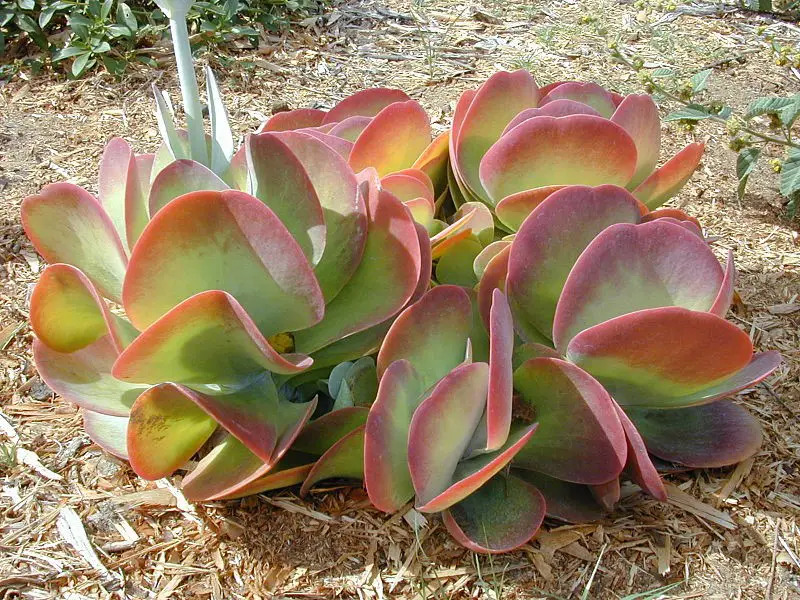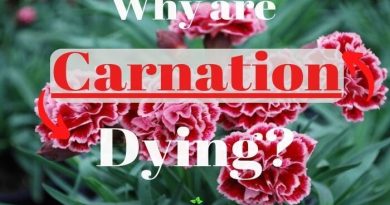Why Are My Kalanchoe Leaves Curling? (& How To Fix It)
Kalanchoe is a popular succulent plant known for its vibrant, colorful blooms and easy-to-care-for nature. Even if I take care of my Kalanchoe plants, they can experience issues, such as curling leaves, which can be both concerning and frustrating for plant lovers like me. If you’re wondering why your Kalanchoe leaves are curling, you’re not alone.
Kalanchoe leaves can curl due to several reasons, including overwatering, under watering, environmental factors such as temperature and humidity, and pest infestations. In some cases, curling leaves may also be a natural response to aging or blooming.
Due to its aesthetic appeal and easy maintenance, kalanchoe a member of Crassulaceae family, are a common house plant. We looked at these solutions to assist you handle the issue of curling leaves on your Kalanchoe:
- Excess Water
- Underwatering
- Using Tap Water
- Sun Exposure
- Improper Potting
- Unstable Temperatures
- Low Humidity Levels
- Overfertilizing
- A Pest Problem

Figure 1 Kalanchoe thyrsiflora (habit). Location: Maui, Kalepolepo
Overwatering/ Excess Water
Even if you forget to water your kalanchoe plants, they still thrive. However, they will not accept being overwatered at all. Soggy soil can result from overwatering, poorly draining soil, and/or a container without a drainage hole. Any indoor plant that has wet soil may eventually have serious problems.
Root rot, which may be harmful to a plant, will ultimately develop in soil that is too damp or too squishy. The damage to the roots is typically severe by the time a plant’s leaves begin to curl from overwatering.
Your kalanchoe is actually drying out because it cannot consume enough water since the roots are decaying and are unable to suck in moisture. Therefore, overwatering is a typical beginning error when a plant’s leaves begin to curl.
Kalanchoe does not require abundant watering, on the contrary, soil moisture should be rare and limited. The leaves of the flower have the ability to accumulate moisture.
If the watering of the plant is limited, then its leaves are bright, dense and shiny. Soil overflow leads to softening of the leaf plate, disruption of the functionality of the root system and a sluggish appearance of the flower.
Solution
Start by stopping irrigation i.e., watering to rescue a Kalanchoe that has been overwatered. Then, determine whether switching to a healthier soil mix is essential.
Behead the plant to prevent it from spreading if you see any black patches on the stem. Prior to planting it again, make sure to remove any black spots and allow the ground to fully dry out (3 to 5 days).
Underwatering
Curled leaves and wilting are common signs of an underwatered Kalanchoe. This may occur as a result of poor soil drainage or frequent, inadequate irrigation.
Using a porous container rather than an absorbent one to enable greater circulation around the roots may be another cause of underwatering.
Rare and poor soil moisture is also undesirable for Kalanchoe. The leaves of the flower are simply not able to accumulate enough water in themselves to last for a long time. If the flower is deficient in moisture, then its leaves wither, dry and fall off.
Solution
If so, switch your container for something more capable of absorbing moisture, such as terracotta clay pots, which are preferable to plastic ones. If they don’t seem to be receiving their fair share from what nature provides, you might need to give them more water regularly.
Give Kalanchoe some time in between watering since plants develop more quickly when given the time to rest before each irrigation. When the top two to three inches of soil fully dries up, not just a little bit, but entirely, is the ideal time to water Kalanchoe.
Using Tap Water
Watering indoor plants usually includes using tap water. Sadly, tap water contains salts and other elements that eventually produce a buildup in the soil. Excessive mineral and salt buildup affects the pH of the soil and prevents Kalanchoes from collecting nutrients like nitrogen.
Moistening the soil (or spraying the foliage) with cold water often leads to lethargic foliage. It is also undesirable to water the plant with ordinary running water. The ideal water for watering Kalanchoe is settled for 3 days, at room temperature.
Solution
Repotting the plant with fresh soil and purified water is the best option.
Too Much Sun Exposure is Bad for Kalanchoe
Even though Kalanchoe thrives in an extremely hot area, its leaves don’t respond well to prolonged sun exposure or intense heat. A Kalanchoe need sufficient indirect sunlight to survive, but not so much that the leaves begin to curl. This indicates that you should place your Kalanchoe plant in a location with little to no shadow or a corner with indirect sunlight.
If the leaves curl and at the same time change color to burgundy, then the plant is in a place that is too lit, direct rays fall on it for a long time during the day. In this case, shade the flower and spray it during the day.
The Kalanchoe needs a lot of light to grow properly, therefore it should be placed in a bright area, preferably with indirect sunlight, to prevent its leaves from curling.
If you place the Kalanchoe indoors, try to put it in a bright window. A window facing east or west is best, as it will avoid the strongest sunlight hours, but still receive the softest early or late day sunlight.
Solution
Move the Kalanchoe once again if you see the leaves curling or turning red. The ideal place is where they receive indirect light, which is away from the window. If the leaves were curled by direct sunshine, they would straighten themselves within a few days.
Improper Potting
When it comes to the growth and development of Kalanchoe, soil is key. They grow best on arid, sandy soil that is well-drained and deficient in minerals.
Even though we are aware that you only want the best for your plant, the majority of soils and fertilizers on the market aren’t designed for kalanchoes. They just serve to exhaust the Kalanchoe as it struggles to expel all the extra minerals.
Solution
Use of well-drained soil created especially for succulents and a container with several drainage holes can solve this problem quickly.
Unstable Temperatures
When your Kalanchoe is exposed to persistently low temperatures, bad things happen. The leaves may first begin to curl, but with time, you’ll also see black spots and gray mold growing.
A sharp change in climatic conditions. If a flower is moved from a warm room to a cold one (and vice versa), then this will immediately affect its external state. Until adaptation takes place, Kalanchoe will look sickly and lethargic.
Solution
A Kalanchoe grows well in a temperature range of 32 to 95°F. Remember to lightly spritz the leaves of your Kalanchoe with water on the hot days.
Low Humidity
Kalanchoes flourish under humid conditions. Unfortunately, humidity is rarely found in most indoor places, especially when the heater is on during the winter months. Its leaves are under a lot of stress from the low humidity and cold weather, which causes them to curl.
Solution
The issue is more prevalent in the summer due of the air conditioning. It’s preferable to keep a Kalanchoe outside during those periods so it can take advantage of the warm weather and high humidity.
Too Much Fertilizer Can Cause Leaves to Curl
Kalanchoe don’t require a lot of fertilizer, and the majority of indoor potting soil is rather nutrient-rich. The leaves may curl if you apply fertilizer too much.
Curled leaves may indicate an excess of fertilizer since the minerals will accumulate and change the pH of the soil. The soil’s abundance of minerals prevents the plant from absorbing nutrients and water, which results in the leaves curling.
Solution
For Kalanchoe plants, fertilization is only necessary once a month. Try to fertilize your Kalanchoe at least twice a month throughout their blossoming seasons.
Repotting the plant with new indoor potting soil is the best option for plants that are growing in too-fertilized soil. Fortunately, the majority of indoor potting soils provide a good amount of nutrients that the plant may use to flourish. Therefore, it will be at least six months before a replanted plant need fertilization.
Pests Are to Blame for Leaf Curl
A Kalanchoe bug problem can be caused by insufficient circulation, underwatering, and poor cleaning. This just causes the leaves to curl, droop, and, in severe cases, fall off.
Mealybugs, aphids, mites, and other insects may and will munch on the plant’s leaves, depriving them of essential nutrients and causing the plant to dry up like it would if it were immersed.
Kalanchoe is susceptible to thrips, cyclamen mites and leafworms that cause curling. If this is the problem, then an insecticide or miticide treatment will be needed.
Aphids
From my experience Aphids can cause great harm to Kalanchoe by sucking the juice from it’s leaves. After the attacks of aphids the leaves begin to turn yellow and curl, then fall off. Damaged plants become vulnerable to fungal diseases.
Curled leaves found should be cut off and disposed by burning.
With a small amount of the pest, it is enough to wash all parts of the plant 2-3 times with a solution of laundry or tar soap.
Solution
Insects will cause moldy areas on the leaves and start blocking the sunlight if not addressed. Applying a safe, home-made insecticide is the most effective technique to get rid of them.
Neem oil spray can help stop further plant damage, but it must be maintained away from other plants to prevent the bug from spreading. Just be sure you only spray the neem at night to prevent burning the foliage. Rubbing alcohol is a useful tool for getting rid of these pests since it has high levels of ethanol, which dehydrates insects.
How to prevent Kalanchoe Leaves from Curling
Here are some steps you can take to prevent Kalanchoe leaves from curling:
- Water the plant properly: Overwatering or underwatering can cause Kalanchoe leaves to curl. Make sure to water the plant only when the soil is dry to the touch. Also, avoid getting water on the leaves, as this can lead to fungal growth.
- Provide proper drainage: Kalanchoe needs well-draining soil to prevent the roots from becoming waterlogged. Make sure the pot has drainage holes and that excess water can drain away.
- Maintain the right humidity levels: Kalanchoe needs a low to moderate level of humidity. If the air is too dry, the leaves may curl. Place a tray of water near the plant to increase humidity or mist the leaves with water once a week.
- Keep the plant in a stable environment: Avoid exposing the plant to sudden temperature changes or drafts. Keep it in a location with stable temperatures and away from heating or cooling vents.
- Avoid pests: Pests can cause Kalanchoe leaves to curl. Regularly inspect the plant for signs of infestation, such as webbing or small white specks, and take action promptly to prevent pests from spreading.
- Fertilize the succulent: Kalanchoe needs nutrients to grow properly. Fertilize the plant every two weeks during the growing season with a balanced fertilizer.
- Repot your succulent: Kalanchoe may need to be repotted if it outgrows its container. Repot the plant in a container that is one size larger than its current pot, using fresh potting soil.
Conclusion
Finally, Kalanchoe leaves can curl due to a number of reasons such as overwatering, underwatering, weather variables, and insect infestations. To prevent future plant damage, it is critical to determine the source of the problem before initiating corrective measures.
Frequently Asked Questions
The reason for this lack of flowers is mainly because the Kalanchoe needs a hibernation cycle and a certain number of hours of darkness to effectively flower; depending on the area in which you live, these conditions may not apply as they correspond.
If Kalanchoe stops growing, but you do not observe external signs of disease, then the reason may be the wrong soil or lack of nutrients.
In this case, try transplanting the plant into another pot and follow all the rules for caring for Kalanchoe, which we talked about earlier.
The most likely reasons include dry soil, excessive heat, and root damage. If there is too much water in the soil, the seedlings’ leaves will curl up. If the soil is excessively dry, the leaves curl down due to a lack of turgor. In the first case, you just need to water the seedlings, and with excessive moisture, more processes are needed.
The soil is neutralized with potassium sulfate or ash extract. If, after feeding, the leaves of the tomato curled up, and the stem turned purple, this indicates an excess of zinc. Treatment is carried out by introducing organic matter into the soil. A large amount of manganese in the soil causes twisting and corrugation of the leaves.
Leaves curl down and fall off: lack of water. Leaves curl on the sides: too hot or too windy. Leaves curl and turn yellow: too much water. You have to repot the plant and use dry potting soil.




